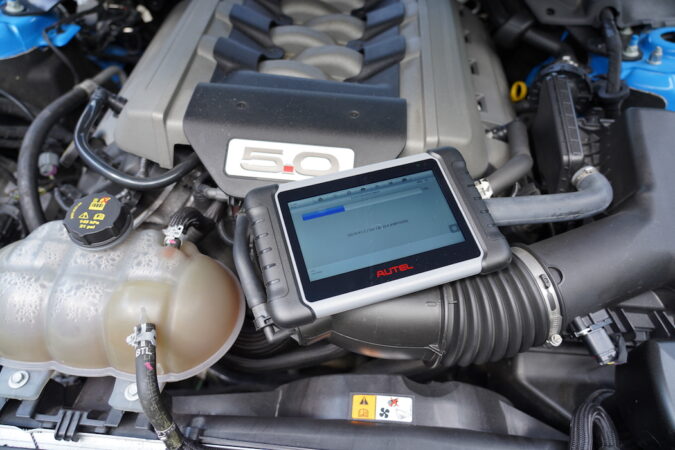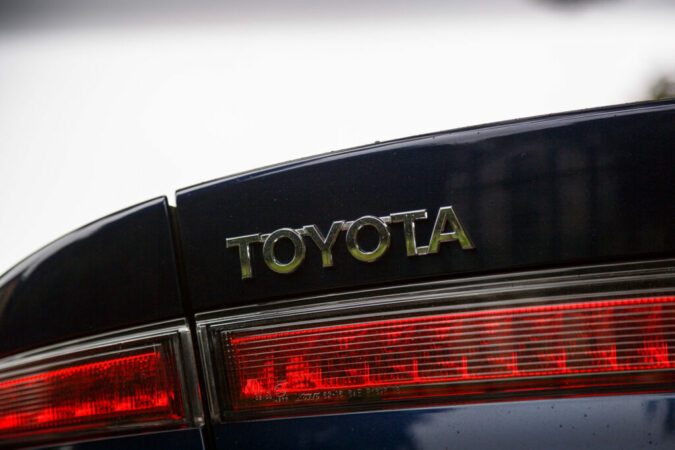The diagnostic trouble code P0136 is classified as a part of the error codes that help a mechanic diagnose a problem with your car. This particular error code, P0136, usually signifies an oxygen sensor circuit with low voltage in bank 1 sensor 2. In layman’s terms, it refers to the second oxygen sensor in bank 1 of the engine. This O2 sensor is usually placed on the side of the engine of the first cylinder. Typically, the oxygen sensor produced about 0.1 MV (millivolts) and 0.9 MV.
- What Is A Diagnostic Trouble Code (DTC)
- P0136 Code
- O2 Sensor Bank 1 Sensor 2
- P0136 Ford
- P0136 Toyota
- O2 Sensor Low Voltage Fix
- Conclusion
- Frequently Asked Questions
What Is A Diagnostic Trouble Code (DTC)?
Seeing a check engine light on your car’s dashboard without knowing the reason behind it can be extremely stressful. That is why the DTC codes were introduced to inform the person working on the car about the problems faced by the car.
A DTC or a diagnostic trouble code is a five-digit code with one alphabet and four numbers. These codes help identify the part or parts that may be malfunctioning and causing problems. These codes usually can be seen on the display of an OBD reader, when it is connected to the car’s system when the check engine light is turned on. The five-digit code starts with a letter and is followed by four numbers (eg. p0102).
Every one of these combinations or the codes relates to a different problem that might cause your car to malfunction. It can be a part that is malfunctioning or a series of problems that might be causing your car to show a code. It can be a generic issue or a manufacturer-specific code. A Diagnostic Trouble Code will not specify the part of the car that needs to be fixed or replaced.
P0136 Code
The DTC or the diagnostic trouble code P0136 usually indicates that there is an issue with the vehicle’s post catalyst oxygen (bank 1 sensor 2). In layman’s terms, the affected vehicle’s power control module has determined a specific signal voltage from the O2 sensor. This code usually pops up when the voltage of this sensor has remained below or above the expected range for too long.
Vehicle technology has come forward in leaps and bounds. It has come far away in the last 40-50 years. What once ran purely mechanical means, is now changed into a highly sophisticated network of computer modules and sensors.
The O2 sensors in modern vehicles are responsible for calculating the fuel trims. A vehicle’s O2 sensor usually provides an input for an algebraic equation. This further determines how much fuel is needed to do each engine bank. A disruption in this feedback compromises the PCM’s ability to calculate these numbers.
Several underlying causes can be the error code P0136. These causes may include a faulty O2 sensor or a compromised exhaust catalyst (to learn more, check out our guide on what does the catalytic converter do and what are catalytic converters, as well as what is a catalytic converter made of). No matter the cause of this error code, a check engine light will remain illuminated until normal system functions are restored.
Symptoms Of The Error Code P0136
The DTC or the diagnostic trouble code P0136 doesn’t come with a huge list of symptoms. This usually happens because the vehicle’s PCM can rationalize this data. It further falls back upon the default values that allow the engine to run normally.
Not only there are limited symptoms but there are even less visible symptoms for this error code. However, the common symptoms people experience usually start with a check engine light. A check engine might mean several things as it is a common symptom for several error codes. Hence to make sure your car is facing the P0136, you need to connect an OBD reader.
Another symptom of the error code P0136 is the fact that your car will start to misfire. Alongside that, there will be reduced fuel consumption efficiency. This may cause the car to have low mileage. One of the last symptoms of the error code P0136 is that there will be an increase in the number of exhaust emissions that come from the tailpipe.
Causes For The Error Code P0136
Several different underlying issues can cause the diagnostic trouble code P0136. Understanding each of these causes can be extremely valuable because it will further help an individual to diagnose this problem. Here is a list of the common problems that can cause the error code P0136.
Faulty O2 sensor – An oxygen sensor is an electronic component that helps heat the exhaust in order to improve its efficiency in detecting the oxygen-exhaust ratio. A malfunctioning or damaged circuit wiring on the oxygen sensor may be the root cause of the P0136 error code.
Failed catalytic converter – A catalytic converter helps remove carbon monoxide and other toxic gasses. A failed catalytic converter can create a problem with the oxygen-exhaust ratio.
Fault in bank 1 oxygen sensor number 2 – Another one of the causes for the error code P0136 is a fault in bank 1 oxygen sensor number 2. This sensor can cause the sensor to misapprehend the exhaust-oxygen ratio. This further results in P0136.
Leak in the exhaust sensor – A malfunctioning or problematic exhaust sensor can be the root cause of the P0136. A broken exhaust sensor can disrupt the oxygen exhaust ratio and cause your cars to show the code P0136.
O2 Sensor Bank 1 Sensor 2
The cars of the modern era have several control modules that operate and look over everything in a car. Most of these sensors are used for engine management. These sensors are responsible for regulating everything, from temperature control to O2 emissions. The ECU or the engine control unit regulates the engine’s performance keeping in mind the data that is taken from these sensors. One of these sensors is the O2 sensor bank 1 sensor 2.
Bank 1 sensor 2 is the second oxygen sensor that is placed on the exhaust pipe. The main purpose of this sensor is to monitor the composition of the gas coming out of the exhaust pipe. It is usually located behind the catalytic converter. There is no noticeable change in the performance of the car. There is also no need to worry about the engine of the car.
The car engine works as a single unit to produce energy that allows the car to move. The engine is further broken down into banks and cylinder numbers which makes it easier for any mechanic to spot a problem. The bank indicates which side of the catalytic converter the O2 is located (bank 1 or bank 2). The sensor number indicates the location of the O2 sensor. Either before (sensor 1) or after (sensor 2) of the catalytic converter.
O2 Sensor Bank 1 Sensor 2 Location
In most of the cars available in the market, bank 1 and bank 2 usually imply the different sides of the engine. When we talk about the different sides of an engine, it is not as simple as the “right side” or the “left side” of the engine.
Having knowledge about the different banks of the engine helps an individual to work on a car properly. It also helps to locate these sensors and ensure that the wrong ones don’t get replaced when the vehicle faces the problem P0136.
Different cars have different locations when it comes to their bank 1 and bank 2. The thing that every car has in common is that bank 1 is always referred to as the side where the first cylinder is located.
The location of sensors 1 and 2 usually is what distinguishes the location even further. Bank 1 sensor 2 can usually be accessed from underneath the vehicle. The sensor number helps an individual know if the oxygen sensor is placed before or after the catalytic converter.
The location of the bank 1 sensor 2 location on a V6 or a V8 engine is usually on the passenger side. This is because these engines have two catalytic converters.
P0136 Ford
The Ford Motor Company has been a major player in the automotive industry for a long time now. Ford has produced several cars, be it pick-up trucks, SUVs, sports cars, sedans, hot hatches, or EVs. Even though Ford obviously has made exceptional cars, no car is perfect. That is why several Ford cars have faced the problem P0136. Cars like the Ford Focus and Ford Mustang have faced this issue.
The error code P0136 on a Ford usually means that there is some problem with the oxygen sensor bank 1 sensor 2. In layman’s terms, the error code P0136 usually pops up when there the oxygen sensor of the car is facing low voltage. This might disrupt the oxygen-exhaust ratio and cause a problem with the emissions of the car.
Ford P0136 Causes
Here is a list of all the common causes that might cause the issue P0136 code in a Ford. These problems are presented in the order of most likely to cause the error code P0136.
Bad Oxygen Sensor – A broken or bad oxygen sensor is one of the most common causes that might trigger the error code P0136 alongside your check engine light. It can be extremely tempting to get your car fixed right away, but it would not hurt to get your wiring harness checked as that can also be the root cause of your problem.
Wiring Harness Problem – The problem that comes with the wiring of the O2 sensor is very susceptible to damage. The wiring that goes to the front and rear of the oxygen sensor is usually placed under the chassis. Hence, it undergoes a lot of punishment from road debris, and they are also subjected to a lot of heat from the exhaust.
Damage To The Terminal – Just like the wiring even the terminal of the oxygen sensor is also open to a lot of damage from the debris from the road. The plug that connects to the oxygen sensor is very easily broken on a Ford. You would want to check the voltage on the car to make sure that the terminal is working.
Exhaust Leak – If there is a leak in your exhaust system, it would cause an increase in oxygen. This can cause your Ford the show the error code P0136.
Ford P0136 Diagnostics
As said before there are not many symptoms that come with the error code P0136 on a Ford. Even though there are a few symptoms of the P0136 problem, there are a number of ways to diagnose this problem. It is possible to diagnose the P0136 with the help of a multimeter.
While using a multimeter, you can make out if the oxygen sensor is working properly. You can see that, whether or not the voltage coming to and from the sensor is correct. With the help of this the individual can make out if their Ford is facing the error code P0136.
If you don’t have a multimeter, the second thing you can do is check the wiring connecting the fuse box and oxygen sensor. If there is a wiring issue you can save a lot of money as you would not have to get a multimeter or an O2 sensor. Ford car’s O2 sensor wiring issues are extremely common.
P0136 Toyota
Toyota’s are one of the most common cars that are available on the market. They are extremely reliable and have a wide range of cars available. From sports cars to SUVs they have several cars in every branch of the market. They have been one of the top manufacturers in the market for a long time.
The error code P0136 is one of the most common problems that is faced by Toyota cars all around the world. It is typically caused by the O2 sensor voltage is not working correctly or malfunctioning. Bank 1 is usually placed on the side of your Toyota engine with cylinder 1 in the firing order.
Toyota P0136 Symptoms
There are not many symptoms that come with P0136. But as soon as this problem hits your car, the check engine light is turned on. In some other cases, there have been some other symptoms as well. These symptoms usually include –
- The engine is running extremely rough
- There is a distinct smell that comes from an exhaust
- The check engine light turns on
- The vehicle gives extremely poor gas millage
Usually, most of the time the error code P0136 does not come with a breakdown risk. But like any other error code, it needs to be fixed right away to get rid of the check engine light. A continued check engine light means that you would not be notified of any new problems that might come up.
A serious error code that has been ignored, it can lead to your car breaking down. On the other hand, if you keep driving with the error code P0136, it can potentially lead to electrical damage and some problems with the catalytic converter.
O2 Sensor Low Voltage Fix
Once you have established the fact that your vehicle is facing the error code P0136, there car certain things you need to follow to get rid of this problem. You need to check certain things to fix the low voltage problem on the O2 sensor.
With so many causes of the error code P0136, you may be wondering about the things you need to fix this problem. Hence, the first thing that you need to do is to thoroughly inspect the whole system starting with the O2 sensor.
Step 1
The first step that you need to take is to carefully inspect the circuit voltage of the sensors and see if they’re outside the actual specifications. If the voltage is fine, the issue may be with the sensor. If the sensor is malfunctioning because of it being broken or dirty, it may have trouble functioning properly. You can clean it or replace it to get over this problem.
On the other hand, if there is an issue with the voltage, then the first thing you need to do is examine the circuit, and inspect if all the wiring and connectors are working properly. There may be some damage or corrosion that might be causing the sensors to malfunction.
To help get rid of this problem you need to replace any piece of wiring or connectors that might not be up to par. You also need to closely inspect the heater circuit to check for any other issues that might be creating problems with your car.
Step 2
If there are no problems with the O2 sensor and everything looks like they are in good condition, you need to look for exhaust leaks. If your exhaust system does not have any leaks, the catalyst converter is the next thing you need to inspect. You need to see if the catalyst converter has sustained any type of damage or corrosion (to learn more, check out our explainer on what’s in catalytic converters).
Step 3
An OBD scanner can also help diagnose the error code P0136 and you can get rid of it from the convenience of your own garage. It takes a lot of patience to actually examine the system. Most of the time the error code might be caused due to a faulty sensor or a failed circuit.
But just because it is common doesn’t mean that is actually the root cause of this problem. Remember if the issue is not solved properly, you can end up doing more damage than good to your car. It can also end up being financially big.
P0136 Code Facts:
- The P0136 code relates to oxygen sensor 2 located behind the catalytic converter on the Bank 1 side of the engine.
- The sensor gathers voltage readings based on oxygen levels in the exhaust and relays it to the Engine Control Module (ECM) to regulate fuel injection levels.
- Sensor 2 voltage is low for longer than two minutes if the P0136 code appears.
- The secondary O2 sensor monitors the catalyst’s performance and is vital in the engine’s closed-loop operation.
- Symptoms of a P0136 code include the Check Engine Light appearing on the dashboard, engine running excessively rich, rough idle, and lack of acceleration.
- A faulty oxygen sensor, a leak in the exhaust portion, or shorting out due to corrosion in the sensor connector are common causes of a P0136 code.
- Prolonged open-loop mode can cause significant damage to the engine internals, like pistons and valves, resulting in high repair bills.
- Driving with the P0136 code is not recommended as it can potentially cause more damage to the engine.
- Qualified technicians should diagnose and inspect the vehicle for the P0136 code, checking the oxygen sensor freeze frame data, wiring, connectors, and catalyst.
- The repair process for a P0136 involves replacing the sensor or repairing/replacing the wiring and connectors and repairing any exhaust leaks.
Conclusion
As said before in this article, P0136 is an error code that indicates the malfunctioning of the O2 sensor bank 1 sensor 2. It may not be one of the most dangerous error codes out there but it may cause some problems later on.
Regular visits to the technician for getting your engine serviced and cleaned can help detect this problem. It doesn’t only help in detecting but also totally avoids this error code. This way, any compromised or corroded part that needs to be replaced can be removed and changed. This helps you to avoid greater damage to your vehicle.
Frequently Asked Questions
Here are some of the questions that people facing this problem usually have.
What Does Code P0136 Mean
The error code P0136 usually indicates that there is a problem with the vehicle’s O2 sensor. In layman’s terms, a P0136 bank 1 sensor 2 means that the sensor located behind the catalytic converter is malfunctioning. The affected vehicle’s PCM has a specific signal or voltage for the O2 sensor. When the voltage on this sensor fluctuates, it triggers the error code P0136. There are several other causes of this problem as well that might have caused your car this error code. Some of these causes that might trigger this error code are a bad oxygen sensor or a problem with the wiring harness. Otherwise, there might be some damage to the terminal or connector or even an exhaust leak.
What Is Bank 1 Sensor 2
Bank 1 sensor 2 is one of the two oxygen sensors that are present in a vehicle. They make sure that the fumes released by the vehicle are clean and in accordance with current emissions regulations. This sensor is usually placed behind the catalytic converter. It is responsible for keeping the fumes released by the car within the government regulations.
Where Is Bank 1 Sensor 2
Bank 1 and Bank 2 on a car are usually referred to as the two sides of the engine. Bank 1 is placed on the side with the first firing cylinder. While on the other hand bank 2 is right next to the second cylinder. Bank 1 sensor 2 is one of the two sensors that are there on the exhaust pipe. This sensor is usually placed behind the catalytic converter. Bank 1 signifies that the sensor is placed on the side with cylinders 1, 3, 5, 7, etc.
What Causes The Low Voltage On The O2 Sensor
There are several factors that usually affect the O2 sensor on a vehicle. Some of the most common causes are an O2 sensor malfunction. A malfunctioning O2 sensor is one of the most common causes for your vehicle facing the error code P136. Alongside that, it also triggers a check engine light which might cause a sense of panic for some owners. In addition, it might be caused by a leak in the exhaust system usually increases the oxygen levels going through the catalytic converter. This can cause your car to show the error code P0136. A broken wiring harness can also be the main source of the error code P0136. A break in the connection can cause the O2 sensor to stop working. Therefore the wiring harness might be the reason why your car is facing the error code P0136.






